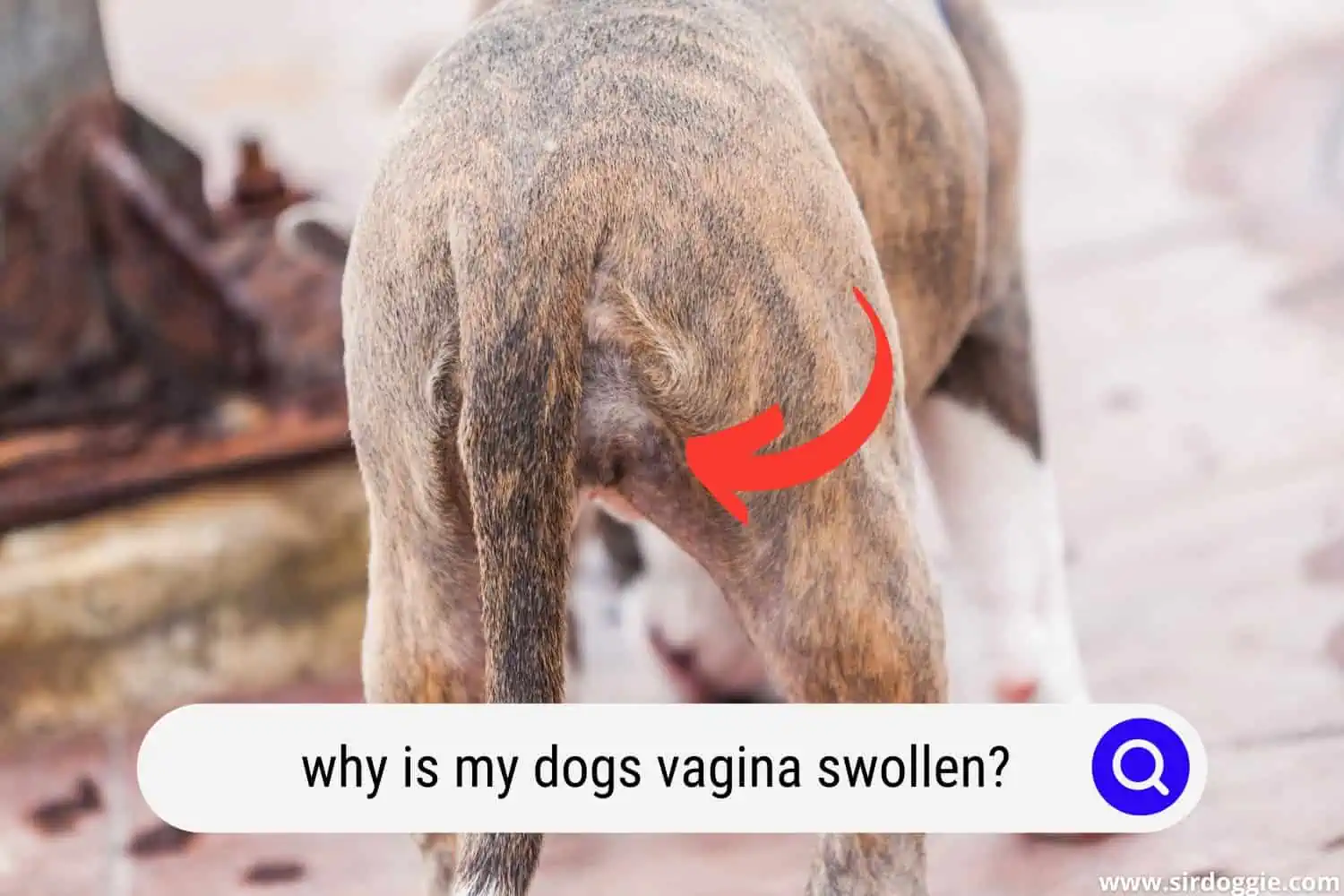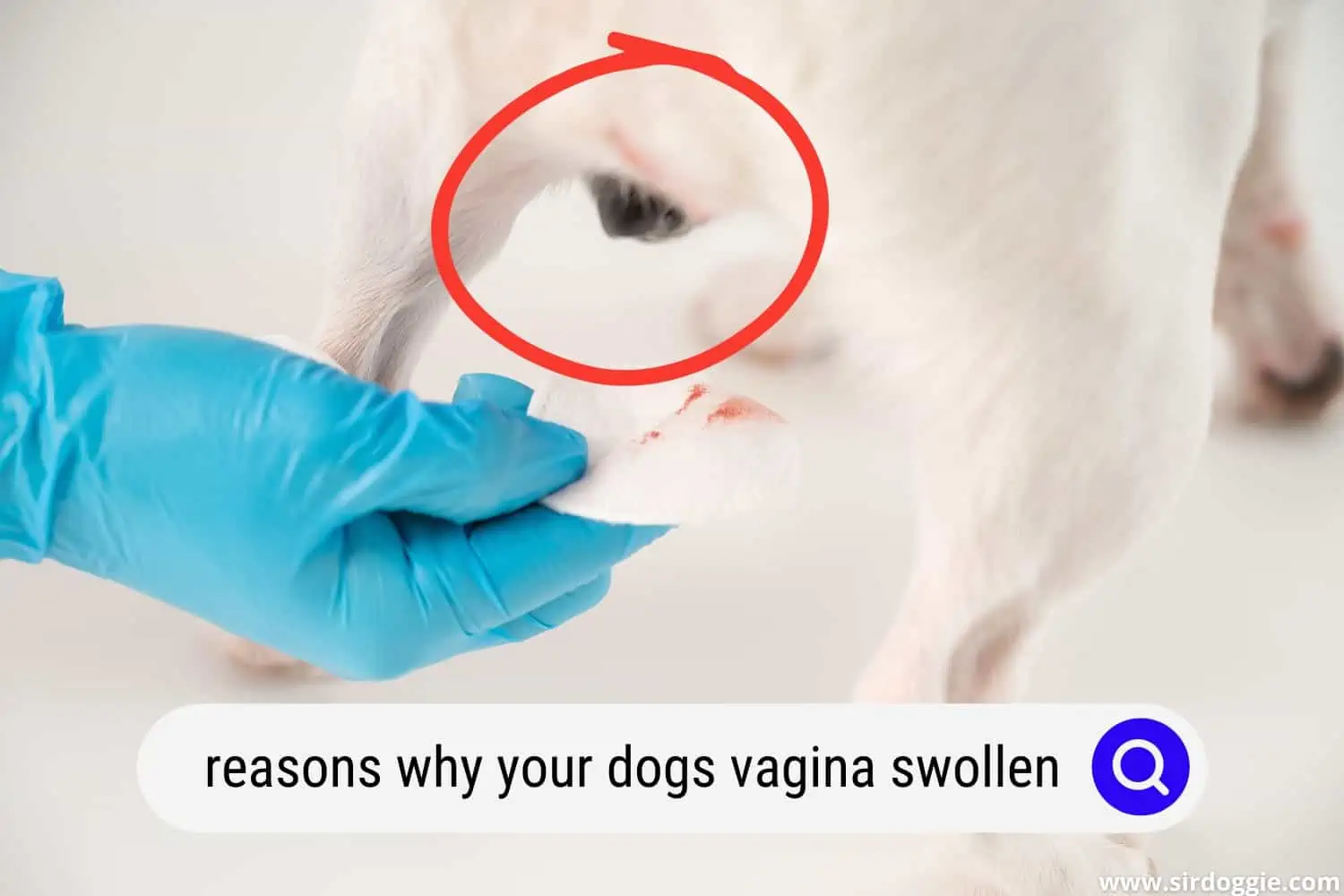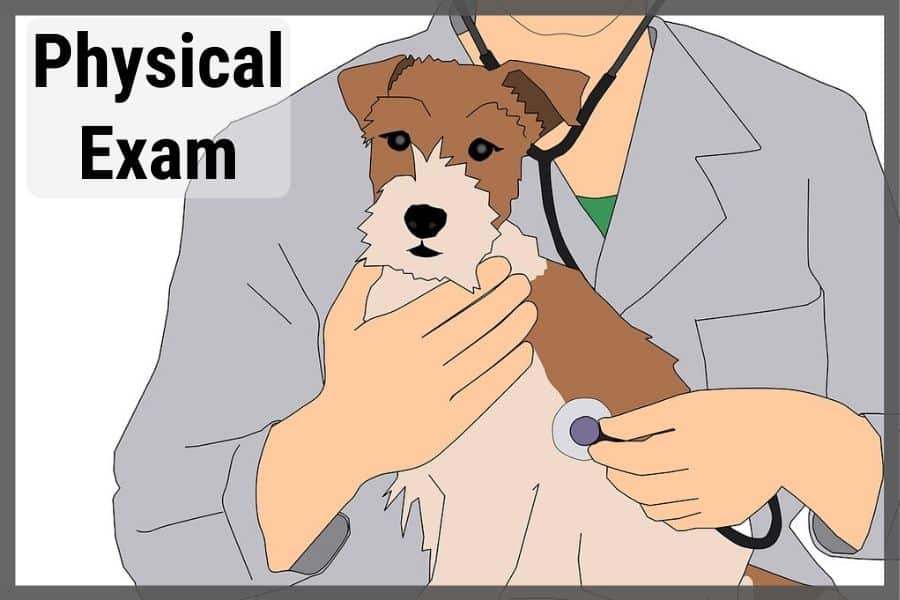Why Is My Dogs Vagina Swollen? [HELP!]
Wondering why your dog’s vagina might be swollen suddenly? A dog’s vagina can become swollen due to allergic reactions, their estrus phase, labor complications, and infection. A condition called vaginitis, which has several causes such as bacterial infection, anatomical anomalies, and cancer can also be the cause.

Are you noticing your dog’s vagina to be looking swollen? Don’t panic just yet. Any part of a dog’s body can be injured, or affected by disease or illness.
It’s always best practice to get your dog checked out as soon as possible by a veterinarian, but I understand why you’ve taken to the internet in search of answers.
This post is not meant to be a guide for diagnoses. In order to know the actual cause of your dog’s swollen vagina, an examination by a veterinarian will be necessary.
But you may be relieved if your dog’s swollen vagina is due to their estrous cycle, and, in particular, their estrus phase. This is a phase in their reproductive cycle, and more specifically when they are “in heat.
During this phase, your female dog will have an increase in the production of estrogen, and this causes the vagina to swell and have a more “outward appearance”. The vaginal tissues will expand and face outwards from the vulva.
Related Reading: First Time Getting A Dog? Read This Guide

Common reasons for a swollen vagina in dogs
There’s more than one reason why your dog’s vagina can become swollen. Some are more serious than others, and a vet is trained in identifying the exact cause. I’ll discuss how vets diagnose the cause of a swollen vagina in the next section.
Let’s take a look at some of the different causes:
Allergic Reaction:
Dogs have a lot less protection than we do for their genitals and it’s a lot easier for them to have their genitals come into contact with something as they venture outside.
It is possible for a dog’s vagina to graze over a poisonous plant or come into contact with an insect. Both of these situations could cause an allergic reaction and, in either case, a trip to the vet is warranted.
There’s also the possibility for your dog to be allergic to a hygiene product you are using, like shampoos or sprays. Just like in people, some doggies don’t tolerate certain product ingredients very well.
If you’ve recently introduced a new product to your doggie then you have reason to believe that an allergic reaction may have taken place.
I wouldn’t recommend waiting to see if this is the cause, however, as time may be sensitive so a trip to the vet is always the best practice.
Foreign Bodies:
Without much protection and with being so close to the elements female dogs are susceptible to getting a foreign body in their vagina which could result in swelling.
Foxtail is a more common foreign body that can become lodged in a female dog’s vagina. Regular inspection after activities can help keep your doggie from developing anything too serious.
Estrus Phase:
The estrus phase is part of the female dog’s estrous cycle (confusing, right?). The estrous cycle refers to the recurring physiological changes that happen due to reproductive hormones and start after sexual maturity.
Before the estrus phase a female dog starts the estrous cycle in the proestrus phase (I know, this is a lot of jargon).
But this is important to be aware of as it’s the beginning of the proestrus cycle that a female dog’s vulva will become swollen.
During the estrus phase, the female dog is sexually receptive, better known as “in heat”. The vulva will still be swollen during this phase and it’s during this phase when male dogs will become more aggressive in trying to mate the female dog.
So, if you’re recognizing that there is a recurring and almost scheduled time when your dog’s vagina becomes swollen then you may have reason to believe it’s due to their heat cycle.
However, if your female dog has been spayed then it would be extremely unlikely that a heat cycle is causing their swollen vagina since spaying eliminates the heat cycle.
Interruptions During Tie:
Since we’re on the topic I’ll mention that any interruptions or forced separations “during tie” may cause a swollen vagina for female dogs. During tie is the term for mating, or when the male starts the mating process by mounting the female.
When mating dogs are interrupted the female can become injured as it’s critical for a male dog to ejaculate before their tie is separated. This is due to the “swelling of the bulb” in a male dog which happens after insertion.
The male dog’s penis is too big to come out at this point and if it’s forced it can damage the vagina.
Pet parents who witness their first “copulatory tie” between dogs may become anxious or panicked as what they observe may be interpreted as painful or alarming.
But hopefully, you understand the importance of not alarming or panicking the dogs as well during their tie as it could cause significant issues for both of them.
Labour Complications:
A swollen vagina during pregnancy for female dogs is relatively “normal”. Their body is changing and preparing for labor, and they’re sometimes getting ready for a large litter.
If your dog is currently pregnant and has a swollen vagina then there may be less cause for concern. But again, only a vet can make that call with confidence.
Vaginitis (infection):
The term vaginitis refers to the inflammation of a dog’s vagina. It can occur at any age and any breed of dog, but it’s relatively uncommon.
Vaginitis can occur due to:
- urinary tract infections
- contamination by feces
- contamination by urine
- injury to the vagina
- abscess formation in the vagina
- vaginal tumors
- zinc poisoning
- issues with urinating
While vaginitis can sometimes resolve itself on its own, it’s still best practice to get a vet to check it out as it could turn into a chronic issue.
Some common signs that your dog’s swollen vagina is due to an infection can include:
- a pus or blood discharge from the vagina
- licking of the vulva
- rubbing their bottoms along the ground
- male dogs sexually interested outside of the heat cycle
- discomfort during urination
- frequent urination
If your female dog ends up having vaginitis then they will likely receive antibiotics from your veterinarian who will develop a treatment plan specific to your doggie’s individual needs.
After two to three weeks on antibiotics, the issue will clear up. If it is or becomes more serious then surgery may be required, but this is only done in severe and complicated cases.
Anatomical Anomaly:
A female dog can have anatomical anomalies in their vagina. Again, a vet would be required to diagnose this as the reason for vaginal swelling.
Vaginal anomalies can happen due to circumferential narrowings in the vaginal vault or by walls of tissue within the vagina known as “vaginal septa”.
Anatomical abnormalities in the vagina may increase the likelihood of urine building up and irritating the “vaginal mucosa”.
It may be tempting to diagnose your dog’s swollen vagina yourself but please keep reading as I discuss how a vet will properly diagnose your dog’s swollen vagina.
How to diagnose your dog’s swollen vagina
While you may be able to educate yourself and get closer to diagnosing your dog’s swollen vagina, it’s always best practice to have a veterinarian do this.
Here are two common steps a veterinarian will take when diagnosing your dog’s swollen vagina.
Medical History:

If you’ve been to the vet a lot then this may be a frustrating experience for you. You may be tired of answering the same old questions. I get it.
But this is a crucial process in your veterinarian’s diagnosis process and you as a pet parent have some, well, a lot, of responsibility here.
Going over your dog’s medical history can help your vet’s tech and vet find crucial information for moving forward. It can even help jog your own memory of an incident that may be a critical “piece in the puzzle”
If your dog is displaying any odd behaviour that is outside of their usual routine then don’t be afraid to take a video. Whether it’s couching, scratching, or vomiting, the way in which they are doing these things may help a vet understand the issue more clearly.
And if you’re able to, collect all of your doggie’s medical records from previous vet trips. Having these on hand for future vet visits can provide a lot of information and save a lot of time.
And be prepared to give information related to your doggie’s current dietary habits and energy levels.
Physical Examination:
After a medical history, your vet may start with a digital examination of the vaginal area. Important to note that these means with “fingers” not a digital camera or scope. Your vet, of course, will have gloves on.
If they do need a better “look inside” then they may opt for a vaginoscopy which is the use of an instrument (other than a speculum) to visualize the vaginal canal.
The instrument will most likely be an endoscope that improves your vet’s capability of detecting any disease. Ultrasounds and radiographs are other imaging techniques that may be used.
The digital examination will allow your vet to check for any abnormalities, such as a tumor or blood-filled cavity, and your vet may also use a speculum during this examination.
Another procedure your vet may opt for is “vaginal tissue scraping“.
Vaginal Tissue Scraping involves a small amount of tissue being removed and sent to the lab to check for bacterial culture and cellular changes. The amounts will then be compared to normal vaginal bacteria.
And there will likely be testing of blood, urine, and feces during the physical examination and diagnostic process.

How to treat your dog’s swollen vagina:
After your vet has found out the reason and cause of your dog’s vaginal swelling a course of treatment will be prescribed.
Unless there is a serious underlying problem then it is unlikely for a dog to be hospitalized or require surgery for vaginitis or other causes for a swollen vagina.
Antibiotics and antiseptics are more common forms of treatment for any sort of vaginal swelling that requires medical intervention.
Some other more common forms of treatment can include:
- anti-inflammatories
- glucocorticoids
- replace hormone therapy
- daily prescription douche cleanings
- daily vaginal wiping with prescribed wipes
If surgery is required then treatment then you will likely have to monitor your dog closely for a few days as they will be sore and uncomfortable. Your vet may prescribe pain-killers and advocate that the dog is as stress-free as possible.

Final Thoughts
In this post, I discussed how a dog’s vagina can become swollen due to allergic reactions, their estrus phase, labor complications, and infection.
A condition called vaginitis, which has several causes such as bacterial infection, anatomical anomalies, and cancer can also be the cause.
This post was not meant to be a guide for diagnoses. In order to know the actual cause of your dog’s swollen vagina, an examination by a veterinarian will be necessary.
It is also your responsibility as a pet parent to try and keep a regular eye out for your dog’s health. This can include frequent observations of your female dog’s vagina to ensure its appearance is normal.
Early detection of a swollen vagina can be the difference between simple medical treatment and an ongoing chronic issue.
I hope this has been helpful and educational, I know I learned a lot researching this topic.

Family Dog Expert Author
Hi there! I’m Stuart, a devoted dog lover and family dog expert with over a decade of experience working with our furry companions. My passion for dogs drives me to share my knowledge and expertise, helping families build strong, loving bonds with their four-legged friends. When I’m not writing for SirDoggie, you’ll find me hiking, playing with my beautiful dog, or studying music.